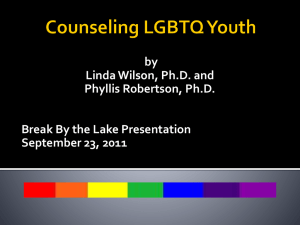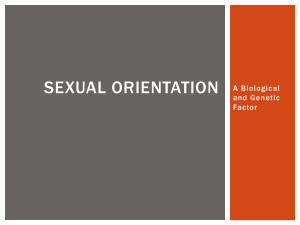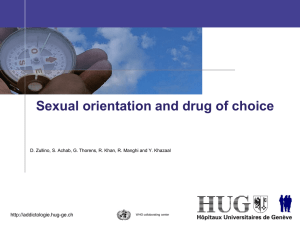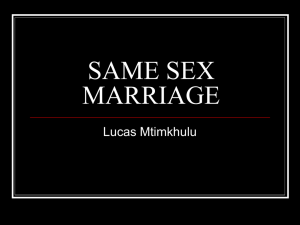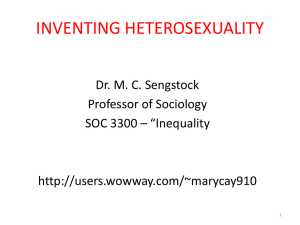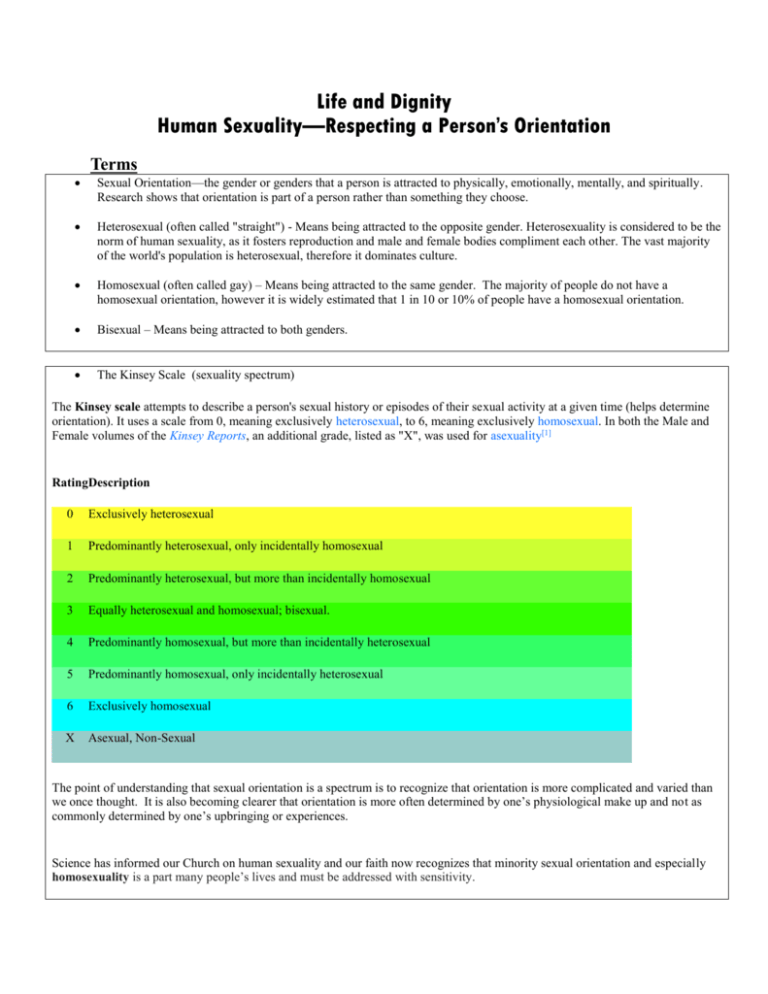
Life and Dignity
Human Sexuality—Respecting a Person’s Orientation
Terms
Sexual Orientation—the gender or genders that a person is attracted to physically, emotionally, mentally, and spiritually.
Research shows that orientation is part of a person rather than something they choose.
Heterosexual (often called "straight") - Means being attracted to the opposite gender. Heterosexuality is considered to be the
norm of human sexuality, as it fosters reproduction and male and female bodies compliment each other. The vast majority
of the world's population is heterosexual, therefore it dominates culture.
Homosexual (often called gay) – Means being attracted to the same gender. The majority of people do not have a
homosexual orientation, however it is widely estimated that 1 in 10 or 10% of people have a homosexual orientation.
Bisexual – Means being attracted to both genders.
The Kinsey Scale (sexuality spectrum)
The Kinsey scale attempts to describe a person's sexual history or episodes of their sexual activity at a given time (helps determine
orientation). It uses a scale from 0, meaning exclusively heterosexual, to 6, meaning exclusively homosexual. In both the Male and
Female volumes of the Kinsey Reports, an additional grade, listed as "X", was used for asexuality[1]
RatingDescription
0
Exclusively heterosexual
1
Predominantly heterosexual, only incidentally homosexual
2
Predominantly heterosexual, but more than incidentally homosexual
3
Equally heterosexual and homosexual; bisexual.
4
Predominantly homosexual, but more than incidentally heterosexual
5
Predominantly homosexual, only incidentally heterosexual
6
Exclusively homosexual
X
Asexual, Non-Sexual
The point of understanding that sexual orientation is a spectrum is to recognize that orientation is more complicated and varied than
we once thought. It is also becoming clearer that orientation is more often determined by one’s physiological make up and not as
commonly determined by one’s upbringing or experiences.
Science has informed our Church on human sexuality and our faith now recognizes that minority sexual orientation and especially
homosexuality is a part many people’s lives and must be addressed with sensitivity.
The Church’s Official View on Homosexuality
The Catechism States
2357 Homosexuality refers to relations between men or between women who experience
an exclusive or predominant sexual attraction toward persons of the same sex. It has taken
a great variety of forms through the centuries and in different cultures. Its psychological
genesis remains largely unexplained. Basing itself on Sacred Scripture, which presents
homosexual acts as acts of grave depravity,141 tradition has always declared that
"homosexual acts are intrinsically disordered."142 They are contrary to the natural law. They
close the sexual act to the gift of life. They do not proceed from a genuine affective and
sexual complementarity. Under no circumstances can they be approved.
2358 The number of men and women who have deep-seated homosexual tendencies is not
negligible. They do not choose their homosexual condition, for most of them it’s a trial. They
must be accepted with respect, compassion, and sensitivity. Every sign of unjust
discrimination in their regard should be avoided. These persons are called to fulfill God's will
in their lives and, if they are Christians, to unite to the sacrifice of the Lord's Cross the
difficulties they may encounter from their condition.
2359 Homosexual persons are called to chastity. By the virtues of self-mastery that teach
them inner freedom, at times by the support of disinterested friendship, by prayer and
sacramental grace, they can and should gradually and resolutely approach Christian
perfection.
To summarize these three passages mean that…
2357_____________________________________________________________________
_________________________________________________________________________
_________________________________________________________________________
2358_____________________________________________________________________
_________________________________________________________________________
_________________________________________________________________________
2359_____________________________________________________________________
_________________________________________________________________________
What are your views on these passages from the Catechism?
__________________________________________________________________
__________________________________________________________________
__________________________________________________________________
Discuss how the institutional, association, and movement aspects of the Church
might differ in with regards to the discussion of homosexual orientation and same
gendered sex, and gay marriage
I__________________________________________________________________
A_________________________________________________________________
M_________________________________________________________________
The Catholic Church’s Views on Homosexuality
To expand on the Church’s view, we must recognize that the Catholic Church is not
against or does not condemn people with a homosexual orientation. The church
is against homosexual acts (same gender sex).
1. The church teaches that a minority sexual orientation such as being homosexual
or bisexual is _____________________________.
2. Any Catholic who discovers he/she is homosexual remains a
___________________ Catholic and is encouraged to participate in parish life like
others.
3. The person who is homosexual like any member of the Church is called to enter
into the _______________________, _________________________, and
_______________________________ of the Church’s teachings on sexual
decision making and chastity. This means that no person gay or heterosexual
should be having sex outside of marriage.
4. The Church believes that homosexual people should not get ________________
or have sex because scripture states that marriage and sex is to take place between
a man and a woman (complimentarity). As well, our faith believes that a marriage
and sex must be open to the procreative possibility (reproduction).
5. The Church regrets that these views/beliefs may cause or contribute to a feeling
of alienation or ______________________.
6. The Church condemns any treatment in which gays and lesbians are the object
of violent malice in __________________________, _______________________,
and or ___________________________ wherever it occurs.
7. The church teaches us to make a distinction between the person and the
person’s acts. While we may reject a person’s immoral acts, we are always called
to love and _______________________ the person. We are not chaste if we
discriminate against or ridicule sexual minorities.
8. The Church calls people with a homosexual orientation to choose the
________________ life vocation.
WORD BANK: full, not sinful, thought, speech, action, married, awareness,
analysis, practice, discrimination, respect, single
Orientation, Sexual decision-making, and Vocation: The Teachings of the Catholic Church
Not every person is born with a heterosexual orientation. Approximately 5% of the US population
identifies as gay or bisexual and it is estimated that approximately 11% of Americans may have a
minority sexual orientation (gay or bisexual) (Gates, The Williams Institute, 2011). Studies on asexual
orientation have not been widespread. The number of teens who actually identify as gay, lesbian, or
bisexual tends to be between 1% and 8%. However statistics are not extremely accurate because
adolescents appear to be less willing to disclose a stigmatized identity, even in presumably anonymous
and confidential surveys (JOURNAL OF ADOLESCENT HEALTH, 2004).
According to the Catechism of the Catholic Church, those with a homosexual orientation are most likely
born with this orientation (2358). The Catholic Church is not against a person’s orientation no matter
what the orientation is. The Church is against sex outside of marriage and is also against same gendered
sex (CCC 2357 -2359).
It is important to distinguish between orientation and sexual decision-making (behavior). A person who
has an orientation does not always act on the orientation. For example, many priests regardless of
whether they identify as having a homosexual, bisexual, or heterosexual orientation do not act on their
orientation because they have vowed not to engage in romantic relationships and remain celibate (do not
have sex). In addition, some heterosexual, homosexual, and bisexual people do not act on their
orientation (abstain from sex and romantic relationships) because they choose the single life vocation.
The Catholic Church states that no matter a person’s sexual orientation, they are called to discern their
vocation and be chaste in this vocation. For those with a religious life vocation, chastity means celibacy.
For those with a single life vocation, chastity means celibacy. For those with a married life vocation,
chastity means a commitment to unconditional love, faithfulness/ permanence and openness to children.
But what about people with a homosexual orientation who have discerned that they are called to the
married life vocation? This is a controversial question, and one that the institutional Catholic Church
answers first through defining marriage. The Catholic Church believes that God made marriage for men
and women. Additionally, God designed sex within marriage for the purpose of uniting the man and
the woman and for procreation. Gay marriage doesn’t adhere to the definition of marriage because it is
not between and man and a women and same gendered sex is not following natural law (male /female
complementarity) and cannot produce new life. Additionally, the Church believes that homosexual people
are especially called to the vocations that include celibacy (religious life and single life). God needs
certain people to be single because single people often have a greater capacity (more time and energy and
not exclusively devoted to immediate family) to do specific work that builds the Kingdom of God.
This answer doesn’t fully satisfy homosexual people who feel deeply called to the married life vocation.
A person with a homosexual orientation in this situation would question, “how could I be wrong about a
call to the married life vocation when it is felt so strongly and when I prayed about it?” The Catholic
Church (priest /counselor), would suggest the person with a homosexual orientation called to the married
life should attempt to live out a prayer-filled life of celibacy supported by friends, family members, and
the Church community.
Homosexual people who feel called to married life and who cannot accept this message from the Catholic
Church, often choose to get married in other Churches. For example, some United Church ministers
solemnize marriages for same-sex couples.
1. Is the Church against minority sexual orientations (homosexual, bisexual, asexual)?
2. What does this mean, “A person who has an orientation does not always act on the orientation.”?
3. What are all people called to regardless of their orientation and vocation?
4. What is the Catholic Church’s view on marriage?
5. What vocations are homosexual people especially called to and why?
Discrimination of GLB
Q: How many of you have heard gay-negative words or expressions in the halls, or in the class room,
amongst your peers, maybe at home…?
Q: How does a person who is gay or questioning whether they are gay feel when they hear such words?
Discrimination in the schools and in the wider community
A growing number of studies identify sexual orientation as an important characteristic in monitoring the
health of youth and adults, because of health disparities linked to sexual minority status [2]. Sexual
minority adolescents (i.e., those who identify as gay, lesbian, or bisexual [GLB], have increased
likelihood of several health risks compared with heterosexual peers. They are more likely to experience
violence victimization, such as harassment in school, assault in the community (JOURNAL OF
ADOLESCENT HEALTH ,2004).
The experience of discrimination in their schools and community is widespread. The most pervasive
form of discrimination is verbal ridicule and bullying. Gay youth also experience physical bullying as
well, especially by other males. Because they are often isolated, many gay youth experience fear, shame,
anger, depression and anxiety. Gay youth more often engage in high risk or self destructive behaviors
such as alcohol/drug abuse, cutting, homelessness, suicide.
What are the major challenges faced by gay people in the Catholic Community?
gay Catholic student (read the reflections)
*
*
*
gay Catholic educator
*
*
*
gay Catholic priest
*
*
Stats on Discrimination of GLB and the impact of isolation/ discrimination
REJECTION/ HARASSMENT
The average age to “come out” to one’s self or in other words recognize their orientation is 15 or 16. This is the
same age in which maintaining peer relationships (belonging) are a number one priority.
50% of all gay and lesbian youth report that their parents reject them due to their sexual orientation.
(Gary, 1987).
26% of gay and lesbian youth are forced to leave home because of conflicts over their sexual orientation
(US Department of Health, 1989).
59 per cent of LGBTQ high school students reported they were verbally harassed, compared to seven per
cent of non-LGBTQ students. 25 per cent of LGBTQ students indicated being physically harassed due to
their sexual orientation, compared to eight per cent of non-LGBTQ students (Climate Survey on
Homophobia, 2009).
The most common reason for harassment was a student’s appearance or body size. The next most
common was perceived sexual orientation.
SUICIDE & DEPRESSION
Suicide is the leading cause of death among gay and lesbian youth. Car accident is the number one cause
of death for heterosexual youth. Sexual minority youth are 2 to 4 times more likely to attempt suicide
than heterosexual youth (Shapiro, 2008). Between 30 and 40% of LGBT youth, depending on age and sex
groups, have attempted suicide (Preventing Suicide, 2011).
80% of gay youth report experiencing severe social and emotional isolation, anxiety, depression (Hetrick,
1987).
Family Acceptance Project at San Francisco State University, shows that adolescence who were rejected
by their families for being LGBT were 8.4 times more likely to report having attempted suicide.
HOMELESSNESS / SUBSTANCE ABUSE / HIGH DROP OUT RATES / HIGHER RATES OF CRIMINAL PUNISHMENT
Service providers estimate that gay, lesbian and bisexual youth make up 20-40% of homeless youth in
urban areas. In a study of male teenagers self-described as gay or bisexual, 27% moved away from home
because of conflict with family members over sexual orientation. Almost half had run away from home at
least once (Gay and Lesbian Task Force, 2007).
Gays and lesbians are at much higher risk than the heterosexual population for alcohol and drug abuse
(National Institute on Alcohol and Alcohol Abuse, 2005).
Approximately 28% of gay and lesbian youth drop out of high school because of discomfort (due to verbal
and physical abuse) in the school environment. Gay and lesbian youth’s discomfort stems from fear of
name calling and physical harm. Gay and lesbian youth are at greater risk for school failure than
heterosexual children. Academic failure, lack of student involvement and low commitment to school are
profound for gay and lesbian youth because schools are neither safe, healthy nor productive places for
them to learn (PFLAG Report).
73 per cent of LGBTQ students reported they felt unsafe at school, compared to 20 per cent who did not.
51 per cent of LGBTQ students reported they did not feel accepted at school, compared to 19 per cent of
non-LGBTQ students (Climate Survey on Homophobia, 2009). LGBT students are three times as likely as
non-LGBT students to say that they do not feel safe at school (Teasing to Torment: School Climate in
America, A Survey of Students and Teachers, 2005).
Lesbian, gay and bisexual (LGB) adolescents are about 40 percent more likely than other teens to be
punished by school authorities, police and the courts (Yale University, journal Pediatrics, 2011).
What can we do to lower these stats? (work with a partner)
What can students do?
What can teachers do?
What can the whole school do?
Theological / Biblical Aspect of the Church’s Views on Homosexuality
Many people including Catholics believe that the Bible condemns or bashes people who are homosexual. Quite
often this is a result of a misinterpretation of the Old and New Testaments. By carefully reading the Bible and
understanding some of the context (culture of the time, morality and taboos of the time, purpose / audience), we
can gain a fuller understanding of the scriptural passages that discuss homosexuality.
a) There are less than 10 passages or stories that are explicitly connected to homosexual or same gender sex. There
are no passages that discuss homosexual orientation since the ancient Jews did not understand orientation.
b) In all these passages the Biblical writers are not against the homosexual orientation (as there is no understanding
of homosexual orientation), but are rather against homosexual acts or to be more specific, same gender sex.
c) One of the most well known stories used to call for harsh punishment of homosexual acts is the story of Sodom
and Gomorrah. Whether the primary offense for the destruction of the cities of Sodom and Gomorrah related in
Genesis was that of homosexuality has been much disputed in recent times. The arguments are over the words used
and how these words have been translated as well as the reason God destroyed the people. The linguistic controversy
is based on the passage where the inhabitants of Sodom and Gomorrah were wanting to ‘know’ the two men that
Lot was protecting. ‘Know’ is taken to mean have sex with but then in the context of the story the men from
Sodom are wanting to forcefully know the two men. This would then be rape. So the wicked offence is rape.
Others say that rape is not the reason God destroyed Sodom because in the story Lot (a righteous man saved by
God) offered his virgin daughters to be “known” or raped and the men of Sodom refused.
Then are we to assume that God disapproves of homosexual sex (same gender sex) but rape is ok or is it just
homosexual rape that God disapproves of. The point is the passage is not entirely clear. It is also unclear if God
destroys Sodom for a number of “wicked” behaviors. The story of Sodom and Gomorrah is referenced by the
prophets and in each reference the reason God destroyed the city has something to do with treating people poorly.
The story after The Destruction of Sodom and Gomorrah called the Origin of the Moabites and Ammonites
explains how Lot’s daughters trick their father in order to produce offspring with him. Those believers who
interpret that God destroyed the people of Sodom because they committed sexual taboos cannot explain why God
lets the daughters of Lot live when they too violated sexual taboos. Since, there is no mention of God destroying
them, are we to assume that incest is less a sin than the sin of same gender sex or the sin of rape in Sodom and
Gomorrah?
Let us also consider the sin of Onan (Genesis 38:8-10), which is coitus interruptus or withdrawal. He was violating
the duty of Yibbum (according to the law, the brother of a man who died without children has an obligation to marry
the widow). Onan was struck down and killed by God because he "spilt his seed upon the ground" while he had a
duty to impregnate his brother in law's wife. If we take this story literally as many take Soddom and Gomorrah
literally, then we should see coitus interruptus as serious a sin as same gender sex; one that is also punishable by
death.
Some sexual taboos that are now considered immoral and illegal were acceptable at that time in history. For
example, In ancient Hebrew culture it was acceptable to have many wives (polygamy) or to marry one’s half sister.
Homosexual acts (same gender sex), however, were considered taboo (toevah) by the ancient Hebrews. Why were
homosexual acts (same gender sex) considered taboo and not polygamy or marrying a close relative?
Homosexual acts were part of some of the pagan (polytheistic) religious rites and rituals. The Hebrews (Jewish
religion) were always trying to prevent the corrupting influence of pagan religious beliefs and idol worship because
they had made a covenant to worship the one God, Yahweh. Idolatry and doing anything associated with idolatry
(like same gender sex) would be a breaking of the covenant. It is clear that God does condemn male and female
prostitution and the pagan idol worship associated with it in Deuteronomy 23:17-18.
17 (A)
" None of the daughters of Israel shall be a cult prostitute, (B)nor shall any of the sons of Israel be a cult prostitute.
"You shall not bring the hire of a harlot or the wages of a dog into the house of the LORD your God for any
votive offering, for both of these are an abomination to the LORD your God.
18
d) Some of the New Testament Passages against homosexual acts are in the context of pagan idol worship rituals
Romans 1:20-27 (New International Version, ©2010)
20 For since the creation of the world God’s invisible qualities—his eternal power and divine nature—have been clearly seen,
being understood from what has been made, so that people are without excuse.
21 For although they knew God, they neither glorified him as God nor gave thanks to him, but their thinking became futile and
their foolish hearts were darkened. 22 Although they claimed to be wise, they became fools 23 and exchanged the glory of the
immortal God for images made to look like a mortal human being and birds and animals and reptiles.
24 Therefore God gave them over in the sinful desires of their hearts to sexual impurity for the degrading of their bodies with one
another. 25 They exchanged the truth about God for a lie, and worshiped and served created things rather than the Creator—who
is forever praised. Amen.
26 Because of this, God gave them over to shameful lusts. Even their women exchanged natural sexual relations for unnatural
ones. 27 In the same way the men also abandoned natural relations with women and were inflamed with lust for one another. Men
committed shameful acts with other men, and received in themselves the due penalty for their error.
28 Furthermore, just as they did not think it worthwhile to retain the knowledge of God, so God gave them over to a depraved
mind, so that they do what ought not to be done. 29 They have become filled with every kind of wickedness, evil, greed and
depravity. They are full of envy, murder, strife, deceit and malice. They are gossips, 30 slanderers, God-haters, insolent, arrogant
and boastful; they invent ways of doing evil; they disobey their parents; 31 they have no understanding, no fidelity, no love, no
mercy. 32 Although they know God’s righteous decree that those who do such things deserve death, they not only continue to do
these very things but also approve of those who practice them.
This has been described as "the most important biblical reference for the homosexuality debate" (Hilborn 2002,
p. 5). It is also the only apparent reference in the Bible to female same gender sex. It is clear that Paul is
discussing homosexual acts in the context of pagan idolatry. He also writes that God gave them (idol
worshippers) over to shameful lusts because of their idol worship.
There seems to be a misunderstanding that homosexual orientation (attraction or lust for same gender) comes
from a rejection of God and is a punishment from God. There doesn’t seem to be any understanding that the
orientation is often innate (inborn).
Paul goes on to state that such people were filled with all kinds of wickedness which he lists as gossip, being Godhaters and so on. It might be interpreted that homosexual sex leads to evil, greed, jealousy, murder, fighting,
deceit, malice, gossip, and showing no kindness or pity for others. In fact, it is rejection of the God of love that
leads people to hurt each other.
e) Jesus’ message
If Jesus ever said anything specific to homosexuality, it is not recorded in the Bible. He does discuss the sin of
sexual impurity but this is not a specific reference to homosexual acts. Jesus did, however, speak extensively on
being faithful and loving in all relationships. He did also speak about God's unconditional love.
Instead of emphasizing Jesus’ love, some Christians are more concerned with emphasizing passages on homosexual
acts that are not often analyzed within their historical and cultural context. Sometimes these groups of Christians try
to deny homosexuals even basic civil rights using scriptural passages as justification. At the same time, these same
Christians may fail to recognize how gay people have been discriminated against and sometimes killed based on
homophobic perspectives.
Our Catholic Church states that unjust discrimination against homosexual people is a graver sin that homosexual
activity (Washington State Catholic Conference, 1983). This is based on understanding that Jesus’ message is about
love and compassion and never hatred. Jesus’ message was one of unconditional love, forgiveness, and interior
conversion rather than condemnation of others. When a person was sinning, Jesus would challenge the person to
recognize their sin but he would never reject the person. Jesus was preaching a "love ethic" rather than a "sex
ethic."
We must always remember that the overall message of the Bible is to love others as God loves us. Loving others
means care and concern, understanding and compassion, and inclusive behavior of all of God’s people even those
whose behavior we might find immoral.
Catholic school trustees permit clubs focusing on gay students
April 27, 2011
LOUISE BROWN
In a surprise change of heart, Ontario’s Catholic bishops and school trustees have bowed to pressure to
allow clubs that help students who are bullied because they are gay.
While still not allowing “gay-straight alliances,” this marks the first time Ontario’s Catholic school system has
given the go-ahead to clubs that focus solely on homophobia, not just broad “equity” clubs that deal with all
kinds of discrimination.
The Assembly of Catholic Bishops of Ontario and the Ontario Catholic School Trustees’ Association recently
issued the memo asking Ontario high schools to let students form groups that address “bullying related to
sexual orientation,” as early as this fall.
The memo stops short of allowing the “gay-straight alliances” (GSAs) common at many public schools —
and denied at Catholic schools — because those are “associated with activist groups, and the purpose of our
clubs will be to provide support, not activism,” said Nancy Kirby, president of the Ontario Catholic School
Trustees’ Association.
Catholic school boards have come under fire recently for forbidding students to start gay-straight alliances
— even though they have been recommended by Queen’s Park to help promote equity — because of the
Catholic church’s delicate stand on homosexuality which accepts homosexuals as children of God but
condemns the homosexual act as unnatural.
“But our student leaders told us these groups are needed because the resources currently provided in
schools do not do enough to prevent this particular kind of bullying,” said Kirby.
The touchy issue of what to call the groups will be tackled by a province-wide committee of clergy and
educators, students and parents that will hold its first meeting Thursday.
But students at one Mississauga Catholic school say the new directive already has opened the door for them
to launch the gay-straight club they have been fighting for, just not by that name.
“It looks like we’re mainly getting the club we wanted; we just can’t call it a gay-straight alliance or
anything with the word ‘rainbow’ in it, so we’re calling it Open Arms until we come up with something
better,” said Grade 11 student Leanne Iskander, who had been told earlier this year she could not start a
gay-straight alliance at St. Joseph Secondary School.
Iskander said the principal told her group Tuesday the memo means the group can begin meeting on school
property for the first time next week and can hold a special anti-homophobia day June 3 as part of a series
of anti-discrimination events.
“We’ve never been allowed to have an anti-homophobia day before and we’re hoping to get guest speakers.
But they’ll have to be approved by the principal. They don’t want the political affiliation that comes with a
GSA.”
Kirby acknowledged getting “some pressure” to allow gay-straight alliances from the province, “but we acted
because of pressure from the students, not anyone else.”
The Halton Catholic District School Board drew fire last fall for briefly banning GSAs, but on Wednesday
director Michael Pautler welcomed the new directive, saying “students will have the opportunity to form
student-led groups that specifically address issues of bullying related to sexual orientation.”
Natalie Rizzo, a student trustee for the Toronto Catholic District School Board, said there is an
“overwhelming response from students . . . who would really like there to be an emphasis on antihomophobia and learning about anti-homophobia (measures) . . . not learning about that lifestyle, but they
would really like there to be more systems in place to combat homophobia.”
A spokesperson for the Assembly of Catholic Bishops of Ontario declined to comment, noting Kirby speaks
for both groups about the memo, which bears the weighty title “Enhancement of caring for all students in
the spirit of the gospel.”
With files from Kristin Rushowy
Questions:
1) Why is important to have groups that specifically address bullying related to one’s sexual orientation or
perceived sexual orientation?
2) The Catholic schools do not want to be “associated with activist groups, and the purpose of our clubs will
be to provide support, not activism,” said Nancy Kirby, president of the Ontario Catholic School Trustees’
Association. What do you think is the difference between activism and support?
3) How would running one of these support groups be a delicate balance in the Catholic system given the
institutional Church teachings?
4) Watch U Tube videos
It Gets Better – Growing Up Christian daveden5
It Gets Better – Gay Orthodox Jews

